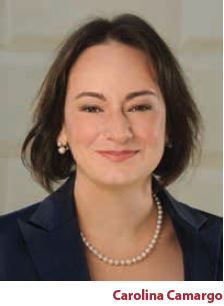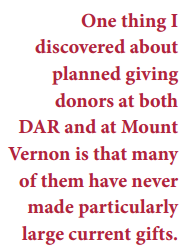 Carolina Camargo is Director of Special Gifts at George Washington’s Mount Vernon in Virginia. Prior to joining Mount Vernon, Ms. Camargo worked as the Director of Development for the Daughters of the American Revolution and the Rappahannock chapter of the American Red Cross. Here she shares some of the history of Mount Vernon as well as the insights she has gained from her varied experiences.
Carolina Camargo is Director of Special Gifts at George Washington’s Mount Vernon in Virginia. Prior to joining Mount Vernon, Ms. Camargo worked as the Director of Development for the Daughters of the American Revolution and the Rappahannock chapter of the American Red Cross. Here she shares some of the history of Mount Vernon as well as the insights she has gained from her varied experiences.
Give & Take: What led you to a career in development?
Camargo: I’ve been working in development ever since college. While still a student, I helped the alumni office organize a number of class reunions and was exposed for the first time to the generosity of donors. After graduating, I was very fortunate to be offered a position in development at the Daughters of the American Revolution (DAR).
Soon after I started at DAR, my supervisor took a leave of absence. I was on my own trying to figure out my new role. While it was a challenging time, it was also a wonderful learning opportunity.
 One of my first responsibilities was data entry, which turned out to have tremendous benefits for me in my career. In development, everything seems to inevitably come back to data. From the very beginning, I learned how critical it is to keep track of relevant information. In this capacity, I worked very closely with our Sharpe consultant, John Jensen, who had been brought in to conduct a planned giving program audit. It became increasingly clear to me that DAR’s future, like that of many other organizations, was going to be heavily dependent on planned giving.
One of my first responsibilities was data entry, which turned out to have tremendous benefits for me in my career. In development, everything seems to inevitably come back to data. From the very beginning, I learned how critical it is to keep track of relevant information. In this capacity, I worked very closely with our Sharpe consultant, John Jensen, who had been brought in to conduct a planned giving program audit. It became increasingly clear to me that DAR’s future, like that of many other organizations, was going to be heavily dependent on planned giving.
In addition to data entry, I oversaw the direct mail program, worked in donor relations, and then became a planned giving officer. Eventually the position of Director of Development became available. After giving it a lot of thought, I decided not to apply for the job as I felt I needed to gain leadership experience at a smaller organization before taking on such a large responsibility.
I left DAR to assume the role of Director of Development at the Rappahannock American Red Cross chapter in Virginia. The two organizations could not have been more different. A lot of the techniques that had worked well at a preservation organization like DAR didn’t translate to a more urgent cause organization such as the Red Cross. Instead of focusing on longer mission concepts surrounding cultural legacies and patriotism, I found that I needed to concentrate on meeting immediate needs. I was still at the Red Cross when the Director of Development position at DAR became available again. They called me back, and this time I decided to take on the challenge.
We expanded DAR’s regional offices around the country and then created a plan for how they would interact with local chapters to promote planned giving. It was at this point that the program really started taking off. The first marketing approach we undertook with the guidance of the Sharpe Group received so many responses that within a month we had to hire an additional person. It was exciting to verify the existence of so much untapped potential.
At DAR I managed major gifts and direct marketing in addition to planned giving. This broad range of experiences helped me realize that I really wanted to focus my career more specifically on charitable gift planning. About three years ago, I made the transition to Mount Vernon to become Director of Special Gifts.

Give & Take: How would you characterize donors to historical preservation organizations like Mount Vernon?
Camargo: For many of our donors, Mount Vernon represents a chance to better educate America’s children about George Washington’s leadership and inspire them to become good citizens.
One thing I discovered about planned giving donors at both DAR and at Mount Vernon is that many of them have never made particularly large current gifts. For instance, we have received several significant testamentary gifts from donors who, when they were actively donating, had contributed $10 or $20, at most. Some 95 percent of the bequest gifts that are now being realized are coming from donors who gave relatively small amounts during their lifetime. Many of these individuals had never been to Mount Vernon but believed passionately in our mission.
Give & Take: What are some of the most effective ways you’ve found to communicate with your donors?
Camargo: A newsletter the Sharpe Group helps produce several times a year informs our donors of the benefits of more thoroughly planning their current and future gifts. This piece also includes donor testimonials and information about the Ann Pamela Cunningham Society, our recognition society for donors who have made provisions for Mount Vernon as part of their estate plans.
I am fortunate that Mount Vernon has a fantastic team of curators and educators. Each month, they put together a summary of recent developments at Mount Vernon. I modify the content of that document and then forward it to the members of the Ann Pamela Cunningham Society. They enjoy realizing they’re part of a group that is helping to make exciting enhancements to Mount Vernon. Knowing that helps keep them motivated and involved.
In addition, the Sharpe Group helped us produce a special piece that our frontline fundraisers use as they make presentations while soliciting gifts and/or thanking donors. It makes a wonderful piece to leave with donors who are considering making a larger current or deferred gift to Mount Vernon but have not yet committed.
Give & Take: Do you have any advice for someone considering development work?
Camargo: Many people think that the role of fundraisers is to constantly ask people for money. While that’s a very important part of it, what fundraisers really need to do is listen. If you’re an active listener and try to piece together the donor’s intent with the organization’s needs, you can build a relationship based on mutual trust that can lead to wonderful gifts donors may have never thought possible. In effect, fundraisers do not necessarily ask for gifts as much as they simply help donors accomplish something they really want to do.
Fortunately, Sharpe consultants Robert Sharpe and John Jensen helped me realize very early on that development work can become a rich, challenging and satisfying career. What keeps me going every day is the pleasure I get from being exposed to so many fabulous people, hearing what they want to accomplish and actually making it happen. It’s exciting to know there’s a lot more I can do for a special place like Mount Vernon.

